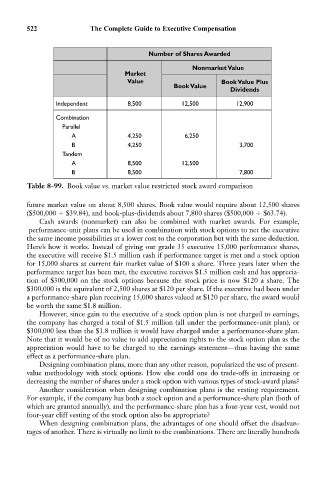Page 536 - Bruce Ellig - The Complete Guide to Executive Compensation (2007)
P. 536
522 The Complete Guide to Executive Compensation
Number of Shares Awarded
Nonmarket Value
Market
Value Book Value Plus
Book Value
Dividends
Independent 8,500 12,500 12,900
Combination
Parallel
A 4,250 6,250
B 4,250 3,700
Tandem
A 8,500 12,500
B 8,500 7,800
Table 8-99. Book value vs. market value restricted stock award comparison
future market value on about 8,500 shares. Book value would require about 12,500 shares
($500,000 $39.84), and book-plus-dividends about 7,800 shares ($500,000 $63.74).
Cash awards (nonmarket) can also be combined with market awards. For example,
performance-unit plans can be used in combination with stock options to net the executive
the same income possibilities at a lower cost to the corporation but with the same deduction.
Here’s how it works. Instead of giving our grade 35 executive 15,000 performance shares,
the executive will receive $1.5 million cash if performance target is met and a stock option
for 15,000 shares at current fair market value of $100 a share. Three years later when the
performance target has been met, the executive receives $1.5 million cash and has apprecia-
tion of $300,000 on the stock options because the stock price is now $120 a share. The
$300,000 is the equivalent of 2,500 shares at $120 per share. If the executive had been under
a performance-share plan receiving 15,000 shares valued at $120 per share, the award would
be worth the same $1.8 million.
However, since gain to the executive of a stock option plan is not charged to earnings,
the company has charged a total of $1.5 million (all under the performance-unit plan), or
$300,000 less than the $1.8 million it would have charged under a performance-share plan.
Note that it would be of no value to add appreciation rights to the stock option plan as the
appreciation would have to be charged to the earnings statement—thus having the same
effect as a performance-share plan.
Designing combination plans, more than any other reason, popularized the use of present-
value methodology with stock options. How else could one do trade-offs in increasing or
decreasing the number of shares under a stock option with various types of stock-award plans?
Another consideration when designing combination plans is the vesting requirement.
For example, if the company has both a stock option and a performance-share plan (both of
which are granted annually), and the performance-share plan has a four-year vest, would not
four-year cliff vesting of the stock option also be appropriate?
When designing combination plans, the advantages of one should offset the disadvan-
tages of another. There is virtually no limit to the combinations. There are literally hundreds

